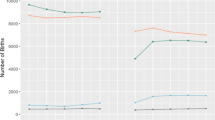Abstract
Anecdotal evidence has suggested increased fertility rates resulting from catastrophic events in an area. In this paper, we measure this fertility effect using storm advisory data and fertility data for the Atlantic and Gulf-coast counties of the USA. We find that low-severity storm advisories are associated with a positive and significant fertility effect and that high-severity advisories have a significant negative fertility effect. As the type of advisory goes from least severe to most severe, the fertility effect of the specific advisory type decreases monotonically from positive to negative. We also find some other interesting demographic effects.
Similar content being viewed by others
References
Angrist JD, Evans WN (1999) Schooling and labor market consequences of the 1970 state abortion reforms. In: Polachek SW, Robst J (eds) Research in labor economics, vol 18. JAI, Stamford, pp 75–113
Apgar V (1953) A proposal for a new method of evaluation of the newborn infant. Curr Res Anest Anal 32(4):260–67
Becker GS (1960) An economic analysis of fertility. In: Coale AJ (ed) Demographic and economic change in developed countries: a conference of the Universities—National Bureau Committee for Economic Research. National Bureau of Economic Research, New York, pp 209–40
Becker GS, Barro RJ (1988) A reformulation of the economic theory of fertility. Q J Econ 53(1):1–25
Belasen AR, Polachek SW (2008) How disasters affect local labor markets: the effect of hurricanes in Florida. J Hum Resour (in press)
Cain M (1981) Risk and insurance: perspectives on fertility and agrarian change in India and Bangladesh. Popul Dev Rev 7(3):435–74
Cain M (1983) Fertility as an adjustment to risk. Popul Dev Rev 9(4):688–702
Deschenes O, Moretti E (2008) Extreme weather events, mortality and migration. Rev Econ Stat (in press)
Heckman JJ, Willis RJ (1975) Estimation of a stochastic model of reproduction: an econometric approach. In: Terleckyj NE (ed) Household production and consumption, vol 40. National Bureau of Economic Research, New York, pp 99–145
Hotz VJ, Miller RA (1985) The economics of family planning. PRC Discussion Paper 85-5, The Population Research Center at NORC and the University of Chicago
Hotz VJ, Klerman JA, Willis RJ (1997) The economics of fertility in developed countries. In: Rosenzweig MR, Stark O (eds) Handbook of population and family economics, vol 1A. Elsevier, New York, pp 275–347
Huynen MMTE, Martens P, Schram D, Weijenberg MP, Kunst AE (2001) The impact of heat waves and cold spells on mortality rates in the dutch population. Environ Health Perspect 109(5):463–70
Lindstrom DP, Berhanu B (1999) The impact of war, famine, and economic decline on marital fertility in ethiopia. Demography 36(2):247–61
Mincer J (1963) Market prices, opportunity costs, and income effects. In: Christ CF, Friedman M, Goodman LA, Griliches Z, Harberger AC, Liviatan N, Mincer J, Mundlak Y, Nerlove M, Patinkin D, Telser LG, Theil H (eds) Measurement in economics: studies in mathematical economics and econometrics in memory of Yehuda Grunfeld. Stanford University Press, Stanford, pp 67–82
Moffitt R (1984a) Optimal life-cycle profiles of fertility and labor supply. In: Schultz PT, Wolpin KI (eds) Research in population economics, vol 5. JAI, Greenwich, pp 29–50
Moffitt R (1984b) Profiles of fertility, labour supply and wages of married women: a complete life-cycle model. Rev Econ Stud 51(2):263–78
NOAA (2007) Weather safety: hurricanes. Safety and preparedness fact sheet. National Oceanic and Atmospheric Administration, U.S. Department of Commerce, Washington, D.C.
Orphanides A (2001) Monetary policy rules based on real-time data. Am Econ Rev 91(4):964–85
Pedicini S (2005) 9 months after the storms. Orlando Sentinel
Pop-Eleches C (2006) The impact of an abortion ban on socioeconomic outcomes of children: evidence from romania. J Polit Econ 114(4):744–73
Pörtner CC (2001) Children as insurance. J Popul Econ 14(1):119–36
Pörtner CC (2008) Gone with the wind? hurricane risk, fertility and education. Working Paper UWEC-2006-19-R, University of Washington Economics Department Working Paper Series
Robinson WC (1986) High fertility as risk-insurance. Popul Stud 40(2):289–98
Rodgers JL, St John CA, Coleman R (2005) Did fertility go up after the Oklahoma city bombing? An analysis of births in metropolitan counties in Oklahoma, 1990–1999. Demography 42(4):675–92
Rosenzweig MR, Schultz TP (1985) Demand for and supply of births: fertility and its life cycle consequences. Am Econ Rev 75(5):992–1015
Schultz TP (1997) Demand for children in low income countries. In: Rosenzweig MR, Stark O (eds) Handbook of population and family economics, vol 1A. Elsevier, New York, pp 543–630
Tolchin M (August 10, 1966) Births up nine months after blackout. New York Times, p 1
Udry JR (1970) The effect of the great blackout of 1965 on births in New York City. Demography 7(3):325–27
Wolpin KI (1984) An estimable dynamic stochastic model of fertility and child mortality. J Polit Econ 92(5):852–74
Yang D (2006) Coping with disaster: the impact of hurricanes on international financial flows, 1970-2002. NBER Working Paper 12794, National Bureau of Economic Research
Author information
Authors and Affiliations
Corresponding author
Additional information
Responsible editor: Junsen Zhang
Rights and permissions
About this article
Cite this article
Evans, R.W., Hu, Y. & Zhao, Z. The fertility effect of catastrophe: U.S. hurricane births. J Popul Econ 23, 1–36 (2010). https://doi.org/10.1007/s00148-008-0219-2
Received:
Accepted:
Published:
Issue Date:
DOI: https://doi.org/10.1007/s00148-008-0219-2




